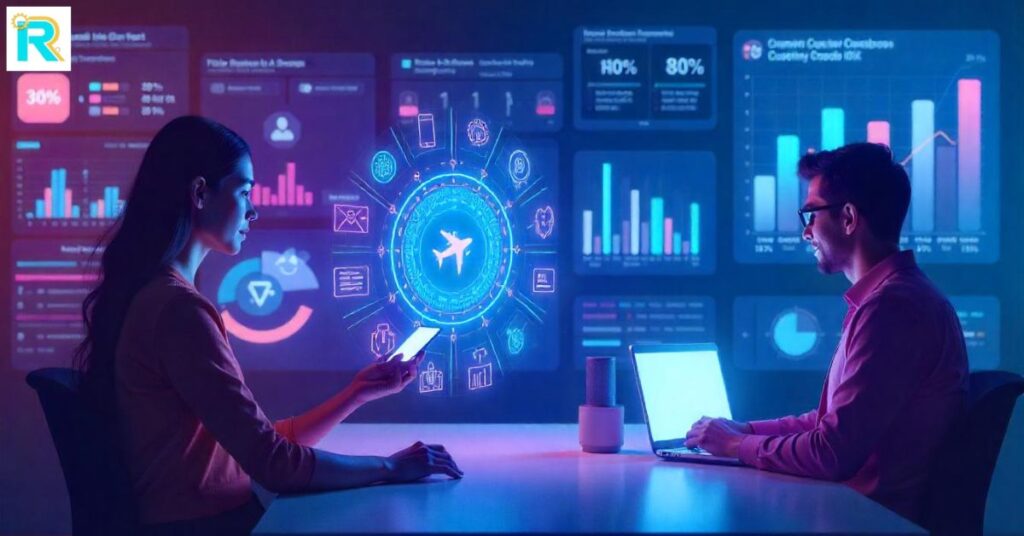Remember the last time you called customer support and waited 20 minutes just to reset a password? Those days are fading fast. Customer service has evolved from smoke-signal-paced mail responses to real-time solutions, and AI chatbots are leading the charge. In the early 2000s, businesses relied on call centers that left customers tapping their feet. By the 2010s, live chat offered quicker fixes, but human agents still juggled endless queries. Now, in 2025, AI chatbots aren’t just answering questions- they are predicting needs, calming frustrations, and building relationships. Picture a tool that learns your habits, adapts to your tone, and never clocks out. This isn’t sci-fi; it’s the new standard for businesses aiming to thrive. Let’s unpack how we got here- and why chatbots are now indispensable.

Contents
- 1 Why AI Chatbots Are Essential in 2025
- 2 Key Benefits of AI Chatbots for Customer Service
- 3 Advanced Features Powering the 2025 Chatbot Revolution
- 4 Real-World Examples of AI Chatbots in Action
- 5 Latest Trends Shaping AI Chatbots in Customer Service
- 6 The Business Impact: ROI and Future Opportunities
- 7 Conclusion for How AI Chatbots Are Revolutionizing Customer Service
Why AI Chatbots Are Essential in 2025
Think about your last online shopping spree. Chances are, a chatbot helped you track an order, suggest products, or resolve a return—and you might not have even noticed. According to a 2025 Salesforce report, 83% of customer interactions are now AI-driven, a staggering jump from 30% just five years ago. Why the surge? Simple: consumers refuse to wait. A 2024 Zendesk study found that 68% of customers abandon brands after one poor service experience. Meanwhile, companies like Sephora and Spotify use chatbots to slash response times to under two seconds, turning casual shoppers into loyal advocates.
For businesses, ignoring AI isn’t just risky- it is financial suicide. Take Shopify, for example. Vendors using AI chatbots saw a 35% drop in support costs and a 27% rise in repeat buyers. In industries like banking and healthcare, chatbots handle all the sensitive tasks like fraud alerts and appointment scheduling, reducing human error and more. The message is clear: in 2025, chatbots are not a “nice- to -have.” They are the difference between staying relevant and becoming obsolete.
Key Benefits of AI Chatbots for Customer Service
Instant, 24/7 Support: No More “We’re Closed” Signs
Imagine it’s 2 a.m., and your flight gets canceled. Pre- 2020, you’d be stuck on hold until sunrise. Today, airlines like JetBlue deploy chatbots that rebook flights, issue refunds, and even toss in loyalty points- all before you finish your midnight snack. For global businesses, this 24/7 availability is not just convenient; it is expected. A Microsoft survey found that 90% of consumers demand immediate responses, and chatbots deliver.
Cost Savings Without Compromise
Hiring a 24/7 human team? That’s a budget nightmare. Chatbots cut costs by automating up to 80% of routine tasks, like tracking orders or updating account details. IBM reports that businesses save $8 billion annually by replacing tier-1 support with AI. But here’s the kicker: these savings don’t sacrifice quality. Forrester found that chatbots resolve 87% of simple queries accurately, letting human agents focus on complex cases.
Turning Satisfaction Into Loyalty
Quick fixes aren’t enough- customers crave personalized care. AI chatbots excel here, too. Starbucks’ Barista Bot remembers your go-to order and suggests seasonal drinks based on past purchases. Result? A 20% uptick in app engagement. When chatbots reduce effort, customers reward brands with loyalty. A 2025 PwC study revealed that 74% of users are more likely to recommend companies with seamless chatbot experiences.
Advanced Features Powering the 2025 Chatbot Revolution
Beyond Keywords: NLP That “Gets” You
Gone are the days of typing “agent” repeatedly to bypass robotic replies. Modern chatbots use Natural Language Processing ( NLP ) to detect sarcasm, urgency ,or confusion. Bank of America’s Erica, for instance, analyzes phrases like “I’m freaking out about my balance” to offer calming guidance and budgeting tips. It is not just understanding words- it is reading between the lines.
Hyper-Personalization: Your Chatbot “Assistant”
Imagine a chatbot that knows you hate spam emails, prefers WhatsApp updates, and always orders gluten-free. Tools like Drift’s AI track user behavior across platforms to tailor interactions. For example, Sephora’s bot uses purchase history to recommend skincare routines, driving an 11% higher conversion rate than human agents.
Omnichannel Magic: Seamless Handoffs
Ever started a chat on Facebook Messenger, then switched to a phone call without repeating yourself? That’s omnichannel AI in action. Zara’s chatbot syncs conversations across Instagram, SMS, and in-store kiosks, letting customers resume chats anywhere. No more “Can you repeat your issue?”- just smooth, continuous service.
Proactive Care: Fixing Problems Before They Blow Up
Modern chatbots don’t wait for complaints. They anticipate them. If a delivery is delayed, Domino’s chatbot texts customers with a discount code before they even check tracking. Similarly, telecom bots monitor network outages and notify users with estimated fix times. This proactive approach cuts complaint volumes by up to 40%, per a 2024 Gartner study.
Real-World Examples of AI Chatbots in Action
Amazon: The Silent Powerhouse Behind Millions of Orders
Amazon’s AI chatbot isn’t just answering questions- it’s running an empire. Behind the scenes, its systems automate 65% of customer interactions, from tracking packages to processing returns. When a user asks, “Where’s my order?” the bot doesn’t just regurgitate tracking numbers. It analyzes delivery delays, offers instant refunds for late items, and even suggests reordering frequently purchased products. During Prime Day 2025, Amazon’s chatbots handled over 12 million queries in a single hour, proving they’re the unsung heroes of peak sales.
Google’s Gemini: From Search Bars to Solutions
Google’s AI, Gemini, has evolved beyond answering trivia. It now resolves 40% of Google Workspace support tickets, troubleshooting everything from crashed spreadsheets to calendar sync issues. For small businesses, Gemini acts as a free IT team- walking users through SEO optimizations or fixing ad campaign errors in real time. The result? A 50% drop in average resolution time for Gmail and Drive users.
Meta’s WhatsApp AI: Turning Chats into Sales
Meta’s AI for WhatsApp Business is redefining social commerce. Retailers like H&M use it to let customers browse collections, check inventory, and pay- all within a chat window. For eg, a user can send a photo of a dress they saw online, and the bot determines the product, confirms size availability, and processes the order without redirecting to a website. This frictionless experience has boosted H & M’s WhatsApp- driven sales by 200% since 2023.
Delta Airlines’ Generative AI: Your Travel Crisis Ally
When storms grounded 500 flights last winter, Delta’s generative AI chatbot became a lifeline. Instead of placing thousands of frantic passengers on hold, the bot rebooked flights, rerouted luggage, and issued meal vouchers- all while explaining options in calming, jargon-free language. The AI even predicted which travelers would miss connections and preemptively adjusted itineraries. Post-crisis surveys showed 89% of passengers rated the experience “less stressful than human-assisted rebooking.”
Latest Trends Shaping AI Chatbots in Customer Service
Voice AI: Talking to Tech Like a Friend
Voice-based chatbots are ditching the robotic “How can I assist you?” for natural banter. Take Bank of America’s voice assistant, which detects stress in a customer’s tone and responds with empathy: “Sounds like this fraud alert has you worried- let’s fix it together.” Google’s latest Duplex update lets users interrupt, ask follow-ups, or even joke around, making interactions feel more like conversations with a savvy colleague than a machine.
Hybrid AI-Human Teams: The Best of Both Worlds
Complex issues like insurance claims or tech repairs now follow a “handshake” model. For instance, when a user tells Allstate’s chatbot about a car accident, the AI gathers photos, location data, and witness details before seamlessly transferring the case to a human agent. The agent receives a summarized dossier, cutting call times by half. This hybrid approach reduced escalations at HP’s support center by 60%, as bots resolve tier-1 issues while humans tackle nuanced problems.
CRM Integration: Chatbots That “Know” You
Modern chatbots sync with tools like Salesforce and HubSpot to act as customer historians. When a long-time client messages Patagonia’s chat, the bot pulls past purchases, warranty details, and even hiking trip preferences from their CRM profile. This lets it recommend products aligned with their values (e.g., eco-friendly gear) or expedite returns for loyal customers. Shopify stores using CRM-integrated bots report a 35% increase in upsells during support chats.
The Business Impact: ROI and Future Opportunities
Costs Slashed, Profits Soared
AI chatbots aren’t just saving pennies- they are transforming bottom lines. A 2025 McKinsey study found that businesses automating customer service reduced operational costs by 30- 50%. Take Vodafone: After deploying AI, its call center expenses dropped by €220 million annually. Meanwhile, Sephora’s chatbot-driven product recommendations contributed to a 25% revenue jump in personalized skincare sales.
Satisfaction Scores Through the Roof
Customers aren’t just tolerating bots—they’re preferring them. A Zendesk report revealed that 90% of users rate AI interactions as “faster and more accurate” than human-only support. KLM Royal Dutch Airlines saw its Net Promoter Score (NPS) climb by 20 points after introducing a multilingual chatbot that resolves 80% of baggage queries in under a minute.
The Future: Beyond Support to Strategic Growth
Forward-thinking brands are using chatbots as growth engines. Starbucks’ AI analyzes order history to push limited-time offers (e.g., “Your usual oat milk latte is back—try it with pumpkin spice today!”), driving a 15% uptick in seasonal sales. Looking ahead, experts predict chatbots will predict needs before customers voice them, like a telecom bot offering extra data before a user realizes they’ve hit their limit.
Conclusion for How AI Chatbots Are Revolutionizing Customer Service
AI chatbots in 2025 aren’t just tools- they are the architects of a customer service revolution. From handling millions of queries to turning frustrated travelers into loyal brand advocates, they have redefined what “support” means. Businesses leveraging these systems aren’t just cutting costs; they’re building deeper relationships, hyper-personalizing experiences, and staying ahead in markets where speed is currency.
Call to Action
The question isn’t whether your business can afford to adopt AI chatbots- it’s whether you can afford not to. With competitors already slashing resolution times and boosting loyalty through automation, delaying adoption risks irrelevance. As Forrester analyst Mary Shea puts it: “In 2025, AI isn’t a differentiator- it’s the price of admission.” Start small: Pilot a chatbot for FAQs, then scale into omnichannel personalization. The future of customer service is here. Is your business ready to meet it?









